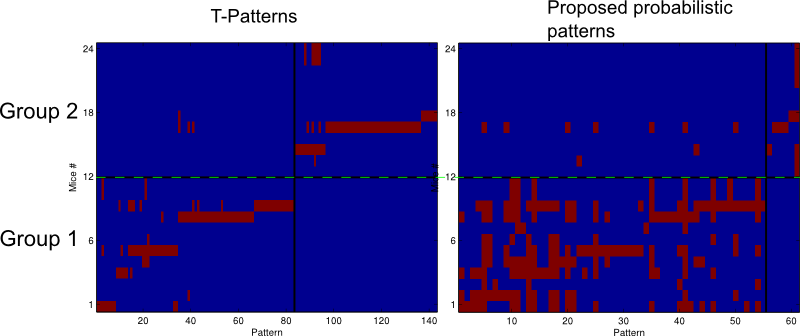Behaviour analysis
In this project we try to build a description and find regularities in animal behaviour. We do this in two steps. First we detect behavioural acts (elementary actions of the animal) by segmenting videorecord of its behaviour. We perform this using the theory of hidden Markov models with some extensions. Second we detect patterns in the sequences of behavioural acts. The most of existing approaches are either poorly describe the peculiarity of behavioral sequences(for example time series analysis from economics, Fourier transforms), or intolerably simplify input data(for example if we would try to analyse just frequencies of behavioral acts).
Our method in some sense is extension of Magnussons’s T-Pattern approach, but fully inferred from probabilistic basis. The key idea is a concept of pattern’s likelihood function, which indicates how it is probable, that given behavioral pattern begins at given time moment.
For practical use our approach brings following novelties into the field.
- It is robust to noisy data especially when there are missed, undocumented or unmarked behavioral acts.
- Thanks to probabilistic nature of method it is possible to describe observed behavior of individual animal in brand new way: by the vector of “responses” of given time series to given set of patterns.
Such “inexact” framework allows to find more relevant patterns. The algorithm is implemented and parallelized for GPU(using CUDA), documented sources and binary builds will be published here soon. The project is carried out in joint collaboration with NBIC centre ofKurchatov Institute.
Illustrative example of input behavioral time sequence.
Examples of crisp and corresponding “fuzzy” pattern which were discovered in real behavioural data
In this experiment we had 2 groups of mice(12 mice in each group). Group 2 consists of mice with defected hippocampus. Group 1 is control group which consists of healthy mice. Horizontal axis — pattern from the given “basis” set. Vertical axis — individual mice, in which behavior we are looking for given patterns. The image shows that using our proposed method, for each group there is some subset of patterns which are found only in behavior of animals from given group. It gives an opportunity to identify by the behavior of animal, which group it belongs to. On the other hand, we cannot find that kind subset of patterns using standard T-Patterns approach. You can notice that there is a mouse(#17) in Group 2, which behavior is very similar to behavior of mice in Group 1. After consulting the experimenters we found out, that lidocaine didn’t fully affect the hippocampus of that particular mouse.
List of relevant papers
- V. Vishnevsky and D. Vetrov. The Algorithm for Detection of Fuzzy Behavioral Patterns. Proceedings of International Conference on Methods and Techniques in Behavioral Research , ISBN 978-90-74821-86-5, 2010. pdf
- E. Lomakina-Rumyantseva, P. Voronin, D. Kropotov, D. Vetrov, and A. Konushin. Video Tracking and Behaviour Segmentation of Laboratory Rodents. Pattern Recognition and Image Analysis , vol. 19, no. 4, pp. 616-622, 2009. link
- D. Vetrov, D. Kropotov, A. Konushin, E. Lomakina-Rumyantseva, I. Zarayskaya, and K. Anokhin. Automatic segmentation of mouse behavior using hidden markov models. Proceedings of International Conference on Methods and Techniques in Behavioral Research , 2008. pdf
- A. Konushin, E. Lomakina-Rumyantseva, D. Kropotov, D. Vetrov, A. Cherepov, and K. Anokhin. Automated distinguishing of mouse behavior in new environment and under amphetamine using decision trees. Proceedings of International Conference on Methods and Techniques in Behavioral Research , 2008. pdf
Have you spotted a typo?
Highlight it, click Ctrl+Enter and send us a message. Thank you for your help!
To be used only for spelling or punctuation mistakes.